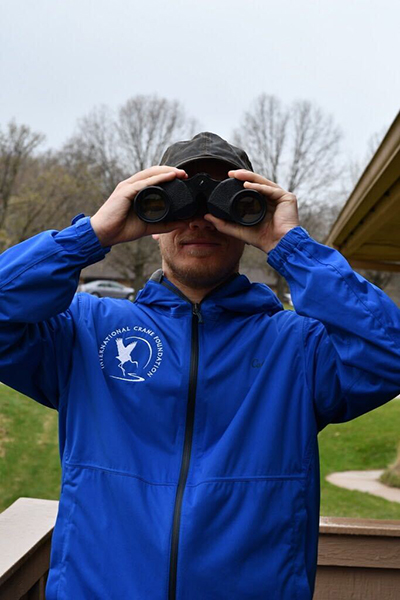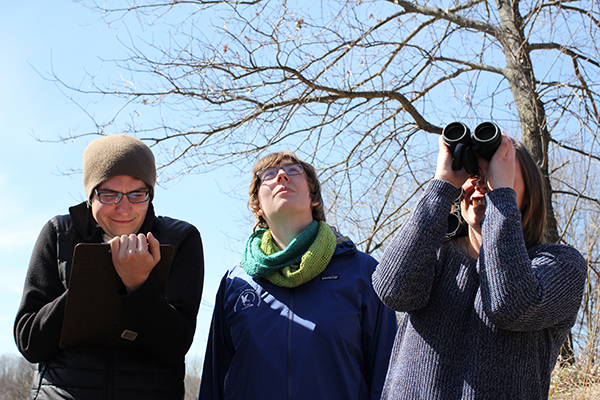Welcome to Week 6 of Quarantine with Cranes! The International Crane Foundation commits to sharing our message of crane conservation with families at home throughout the pandemic. Building off the previous Quarantine with Cranes, this week’s activities provide opportunities for your family to engage in science right from your home. See Week 5 of Quarantine with Cranes here.

Are you eager to participate in scientific research? Although we currently are staying near our homes, we can still join online community science projects. These programs encourage you to log your own discoveries and scientific observations. Your logged observations create data that professional scientists and researchers may use to answer questions about the natural world. Anyone can join these projects. You do not need a background in science!
Activity description: We have gathered several community science projects for your family to join! These projects include Zooniverse’s Snapshot Wisconsin, eBird, the Great Lake Bioblitz and Journey North. Scroll down to the workplan to learn more about each program.
Grades: All ages (including adults)
Time estimate: 3 hours
Topics covered: Science (biology), phenology, animal and plant identification, reading
Materials needed: Internet access, pencil and paper, binoculars (optional)
Adult involvement: Yes
Indoor or outdoor: Both
Links:
Rotten Log Exploration: A Fun Home Activity for Kids AND Adults!
Zooniverse’s Snapshot Wisconsin

Workplan: Begin with the Rotten Log Exploration video from Audubon’s Rowe Sanctuary. After watching the video try investigating a rotten log near your home with your kids. This short activity can be a great warmup exercise to get your family thinking about exploring nature and doing science.

After exploring around your home come back inside and visit Zooniverse’s Snapshot Wisconsin’s website. This community science project asks you to identify animals in pictures from trail cameras placed throughout Wisconsin. In doing this work you help scientists discover new facts about Wisconsin’s wild animal population trends. Keep your eyes peeled for photos of Sandhill Cranes! Make sure to follow the instructions that pop up once you click on the link. Note: you can still participate in this project even if you do not live in Wisconsin.

Next, go to eBird’s website. eBird is a database of bird sightings researchers consult to discover more about birds’ locations and behaviors. Please note you will have to use the browser version of eBird (link provided) to complete the following activity. Once you have clicked on the link to eBird, start exploring birding hotspots in your county.
Instructions: On eBird’s “explore page,” click on the “Explore Hotspots” map. Once you are on the map type your county into the “Location” search bar. The map will then show all the birding hotspots in your county. The darker the hotspot, the more bird species have been observed there. Click on a hotspot close to your home. A pop up will display the number of species recorded on eBird at that hotspot. Click on “view details” to see a list of those species. Set the year to “current year” and then click on a species someone has observed recently at that hotspot. Have your family do some research on that species. Write down information such as how the bird looks, sounds and where it lives. Now that you know a little bit more about this bird, go outside and see if you can find it. It is okay if you cannot find the bird immediately. Birding can be a fun challenge that requires patience, so try to keep looking even if it takes a while. If you have a pair of binoculars go ahead and bring them. Remember to stay safe and maintain proper social distancing!
Now let’s move on to another community science project – the Great Lake Bioblitz! The Bioblitz challenges you to find and record as many living organisms as you can. Their webpage provides information and instructions on how to participate. Last week’s Quarantine with Cranes mentioned the community science app iNaturalist. You will be using this resource to record your observations for the Bioblitz. You have to live in the Great Lakes region to participate in this specific program. However, you can still download and use the iNaturalist app to explore even if you do not live in the Great Lakes area.
Finally, check out Journey North’s website. This site includes numerous projects you can choose from. Each project lets you view and record sightings. Click on the “projects” tab to see a list of the studies you can join. We recommend checking out the monarch butterfly page. You can read about the monarch’s migration and then click on the map to see recent sightings people have reported. Feel free to explore and join the several other Journey North projects too!
What do you think? Please send your feedback to info@savingcranes.org. We would love to see photos of you and your kids exploring the outdoors. We will see you next week for Week 7 of Quarantine with Cranes!
